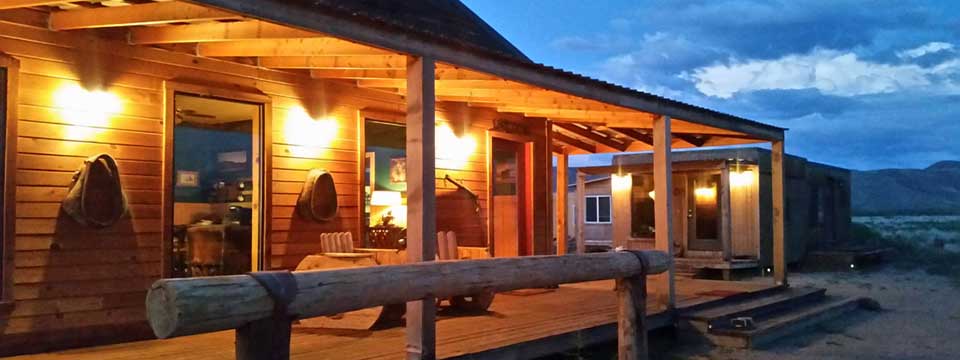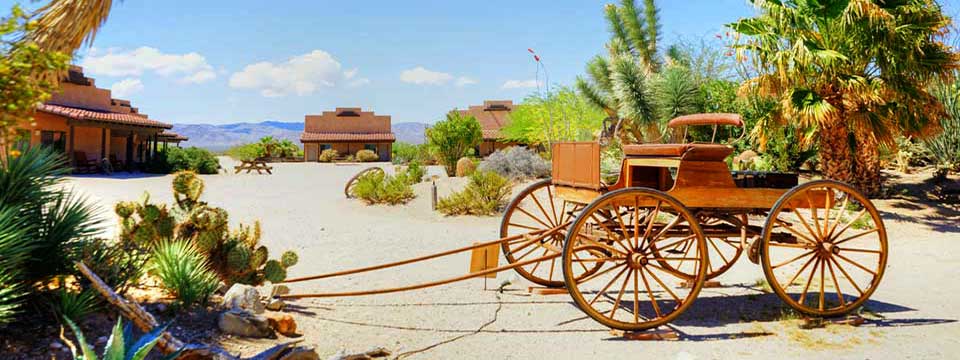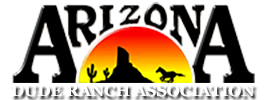
The Circle Z Ranch, which started as a sheep-herding operation in the 1880’s, was developed as a dude ranch in 1925 when the Zinsmeister family of Germany purchased the 5,000-acre spread from the Sanford family who had homesteaded the property. It was the golden age of dude ranching and the Dude Rancher’s Association was just forming. The facilities were opened in 1926 with a capacity of 24 guests. Over the next few years, it was increased to accommodate 70. The average length of stay for a guest then was one month and some families remained the entire season. Private railway cars of some guests remained in town on a siding by the Patagonia station. By 1929, the annual Fourth of July picnic and barbecue at the Circle Z was one of Santa Cruz County’s biggest attractions. Upwards of 2,000 people would attend this event; arriving by train and private car. They were served pit barbecue with all the trimmings, enjoyed band concerts, a rodeo, and a cigar race. A dance in Patagonia concluded the day.
World War II put a crimp in the resort and travel business, and the Circle Z ended up changing hands several times. In 1949 Fred Fendig came from Chicago and purchased the Circle Z. He was the owner-manager for the next 25 years. When Fred Fendig decided to retire and sell the ranch in 1974, there were rumors it would be acquired by a corporation and turned into a land development or tennis ranch. Mr. And Mrs. Preston Nash of Novelty, Ohio, purchased the spread and decided to operate it in keeping with its honored tradition of an old-time family-style ranch with an emphasis on good riding, good food and congenial guests. Their deep interest stems from Mrs. Nash’s many visits to the ranch as a child, with her family, dating back to Zinsmeister’s ownership. They have continued preserving, improving and perpetuating a rare and unique spot in the west.
About fifty miles southwest of Tucson, you will find Elkhorn Ranch nestled into the foothills of the Baboquivari Mountains. Ranching heritage lives strong in the working landscape of the Altar Valley, where the Millers raise horses and neighbors operate successful cattle ranches. The third generation of the Miller family carries on guest ranching traditions pioneered by their grandparents, Grace and Ernest Miller, in the Gallatin Canyon of Montana. In 1945, the Millers found an ideal winter ranch location at what had been the Fresnal Ranch School and before that a cattle ranch homesteaded by Sabino Otero in the late 1800’s. The first guests arrived by the spring of 1946; and after many years of migrating north and south, Bob and Jan Miller settled permanently in Arizona in 1961 to raise their children and focus on the Arizona operation. These days, the Millers continue to welcome many returning guests and new friends to Elkhorn Ranch, a place to enjoy friendly horses, friendly people, and beautiful country
Eighteen-year-old Romaine Lowdermilk purchased 160 acres of Arizona ranchland from the U.S. Land Office for $1.25 an acre. The working cattle ranch was named KL Bar, in honor of Katherine Lowdermilk (the owner’s mother).
The first adobe building, the current Homestead House guest casita, was built as the ranch headquarters and a bunk house for the cattle wranglers. A number of adobe brick building were built over the years by Maricopa Indians who lived on the nearby reservation.
Just nine years after Lowdermilk started the ranch the first paying guests arrived. Kay El Bar was still a working cattle ranch then, but an enthusiastic newspaperman who had visited the ranch spread the word about the “authentic western experience” and soon paying guests started arriving.
Lowdermilk took a partner, Henry Warbasse, with the goal of developing a full-time dude ranch. The first structure they build was the large adobe lodge, which is still used to house guests. ”
Kay El Bar became a full-time guest ranch. Most guests arrived by train at the Wickenburg station, where they were transported by Touring Packard to the ranch.
Romaine Lowdermilk, founder of Kay El Bar Ranch, dies at age 80. He became known as the “Father of the Arizona Dude Ranch” , first establishing Kay El Bar as a guest ranch and later starting other Arizona ranches. He had a second career as one of the first cowboy entertainers.
In recognition of its contribution to the State of Arizona, and for its historical significance, Kay El Bar Ranch was placed on the State Register of Historic Places in 1975.
Kay El Bar was placed on the National Register of Historic Places by the U.S. Department of the Interior in 1979.
“This ranch very well might be home to more history than anywhere else in Arizona.” (Dude Ranching in Arizona, Arcadia Publishing). Rancho de la Osa is a unique convergence of Native American, Spanish, Mexican, ranching, political and Hollywood/celebrity history.
Native American History: The ranch headquarters was originally a village for Tohono O’Odham (once called Papago) Indians and possibly the Hohokam. Many artifacts, including metates and pottery shards have been found and continue to be.
Spanish History: Rancho de la Osa boasts Arizona’s oldest continually used building that was built at the Indian village around 1720 by Jesuit missionaries who had traveled with Father Kino (Kino died in 1711). The building was a mission outpost which served as a place of worship, a trading post and an inn for travelers. Today it is used for special events and ranch gatherings.
The ranch was part of the 1812 Ortiz Brothers Spanish land grant.
Mexico: With Mexican independence from Spain in 1812, the ranch became a part of Mexico.
In 1916 Pancho Villa raided and attempted to take Rancho de la Osa. A cannon ball from that attack was found embedded in the adobe wall of the Hacienda and is on display today.
Ranching: In the late 1800s the ranch was bought by cattle baron Colonel William Sturgis, who built the great Hacienda, which was finished in 1889. The ranch was now part of the United States, following the Gadsden Purchase of 1853. The adjacent acre Buenos Aires Federal Wildlife Refuge restored its own 130,00 acres to the pre-1880s great grasslands of Southern Arizona.
In 1925 Louisa Wetherill, a noted Navajo historian and archeologist came to the area and the ranch, looking for a “lost” tribe of Navajos. They did not find the tribe, but found the perfect place to build a dude ranch. Rancho de la Osa opened to guests in 1926.
Rancho de los Caballeros is a historic ranch resort and golf club situated on 20,000 acres of spectacular Sonoran desert. The Ranch first opened its doors in 1948 and has been owned and operated by the Gant Family since the beginning, and it continues to honor the grand tradition of the Spanish caballeros, the gentleman on horseback, who explored and settled the Southwest. The Ranch has a rich history that has made it what it is today, and though it has evolved over the years, The Ranch has retained the same personal service and charm since its opening.
The Ranchs original construction consisted of 40 main guest rooms, main living room, dining room, saloon and office, swimming pool, one tennis court, barns, corrals, staff quarters and the Gant family home. An airstrip was built in 1951 to accommodate the private planes of early guests. The runway was 2,600 feet long and 120 feet wide and was once used by a DC3. Today, private planes land at nearby Wickenburg Airport. Dallas Gant, Sr., coined the term ranch resort to describe Rancho de los Caballeros in 1951, as he felt is was the best way to describe the propertys fusion of western activities and upscale accommodations.

The land where Sprucedale Ranch is located was homesteaded by Hiram & Maryette Thompson of Springerville, AZ. Sprucedale at that time was called Espero, a Spanish word for hope, and was the post office for the surrounding ranches and homesteads. The Thompsons built their homestead cabin (still in use and still a favorite), two log barns, and a well. They sold the property to Ernest R. & Bertha A. Patterson in 1921. Shortly after the Pattersons bought it, some fishermen came by and asked if they had a place they could stay. The fisherman had been camping and a typical White Mountain Monsoon season had rained on them for several days and they wanted a warm and dry place to stay. The Pattersons had a small cabin that they used for storage that they offered to them. The fishermen had a great time and asked if they could come back the next year. From that simple request, the Pattersons began building Sprucedale Guest Ranch with the addition of three new cabins. In 1941 the Pattersons approached Walter and Faye Wiltbank to purchase Sprucedale for $10,000 at zero interest for as long as they needed to pay. This was quite a change and challenge for the Wiltbanks as they were cattle ranchers and 1941 was at the end of the great depression. Walter and Faye hesitantly agreed and Walter went to work providing for his wife and two small children by adding seven additional cabins, ranching and farming, and by packing hundreds of fisherman down Black River. Faye cooked and sewed homemade clothes, curtains, and quilts while also providing the nearby CCC Camp at Buffalo Crossing on Black River with eggs and homemade butter and cheese. Walter and Faye ran Sprucedale with their four children (Margine, Bud, Emer, Ellis) until Walters passing in 1980. In 1981Sprucedale was handed down to the Emer and Esther Wiltbank and their seven children. Emer added six more cabins bringing Sprucedales rentable cabins to thirteen. Esther focused on adding to Sprucedale by constantly improving the menu, cabin comfort, and overall ranch aesthetic beauty. Emer and Esther retired in 2004 and their youngest son Whitney with his wife and three children are now carrying on the Wiltbank tradition of warm Western hospitality.
The lands that make up Stagecoach Trails Guest Ranch were originally part of the Santa Fe Pacific Railroad. In the 1990’s, the railroad sold over 150,000 acres (200 square miles) of the land for private development when it was decided it was not needed for railroad expansion. This is when the founders, Dan and Carrie Rynders, along with her brother Randy, found an opportunity to build the nation’s first and only completely handicapped accessible dude ranch. Having a daughter with Cerebral Palsy in a wheelchair, the Rynders’ had first hand knowledge of what was needed to ensure a complete barrier free environment. Purchasing close to 400 acres bordering over 400,000 acres of park land, the Rynders’ found the perfect location to build their dream ranch. The surrounding land is still relatively untouched and looks like the true Wild West. It is surrounded by three beautiful mountain ranges and encompasses “Shot up Well” and old well that was used for target practice during World War II. To this day, guests still find old rounds of WWII ammunition when they ride out to Shot Up Well. The lands surrounding the ranch are steeped in rich western history with many stagecoach robberies, tales of buried gold treasure, abandoned gold mines, and the home of Hualapai Indian nation who resided in the Hualapai mountains. Guests still find old relics of the bygone days when traveling out on the trails.
Tanque Verde Ranch – The rich and colorful history of this Arizona dude ranch begins with the Pima Indians. The “Tanque Verde” Ranch is named for the “green pool” and seasonal river that the Indians used as a source of water. They left behind numerous mortar stones and other artifacts as testimony to their passage.
In 1868 the land surrounding the tanks was purchased by Emilio Carrillo, a Mexican hacendado (the owner of a large estate) from Santa Cruz. After Carrillo’s death in 1908, Jim Converse owned the ranch and began inviting eastern dudes to participate in everyday ranch activities. He further extended the business in both the production of cattle and the involvement of tourists until 1955.
In 1957, Brownie Cote purchased the property. He expanded on the existing operation and developed the property into a successful combination of classic western dude ranch and world class resort. In turn, he began a legacy of quality and unforgettable experiences that the Cote family continues to maintain still today.
Located 3 miles West of Tombstone, the ranch borders the historic Scheiffelin Monument where Ed Schieffelin, the founder of Tombstone, is buried. Schieffelin chose this spot for his final resting place because it is near the place he hid from Apache Indians who were hunting for him after they saw his mule’s hoof prints near the only water hole in the Tombstone area.
Owned and run by the Trappman family for over 100 years (homesteaded in 1880), primarily as a cattle operation. The property changed hands into the Deveer family, and other prominent Tombstone families who continued with the cattle operation. In 2009 the homestead part of the property was bought by a German who built the Dude Ranch. In 2014 the Ranch was taken over by the True family who have a 50 year history in owning and operating the White Stallion Ranch in Tucson.
White Stallion Ranch was originally built in the early 1900’s and like most guest ranches, began its life as a cattle ranch. In 1940, Max Zimmerman of Chicago decided to move West and become part of the guest ranch industry in Tucson, which had over 100 ranches at the time. Max named the ranch MZ Bar Ranch and constructed 6 buildings for guests – complete with kitchenettes. The ranch changed hands again in 1948, when a governess to the Dupont family bought it and continued the ranch operation as well as providing housing for air Force personnel and their families. In 1958, Drew and Marge Towne bought the ranch and decided to rename it The Black Stallion after their favorite horse story. They quickly realized that the initials “BS” would be unacceptable, and thus, White Stallion Ranch was born!
In 1965, the Townes sold the ranch to Cynthia and Allen True from Denver, Colorado, which at the time consisted of 17 rooms, 17 horses, and 200 acres. By now the number of guest ranches in the Tucson had dwindled to 30 or so, and the Trues could see what the growth of the city was doing to these properties. They immediately began purchasing adjoining land as it became available, and the ranch grew to its current size of 3,000 acres. Cynthia and Allen dedicated the rest of their lives to the ranch and to raising their two sons Russell and Michael in the business. They succeeded, and to this day the ranch is owned and operated by the second generation Trues, honoring those same traditions of Western hospitality at White Stallion Ranch.
